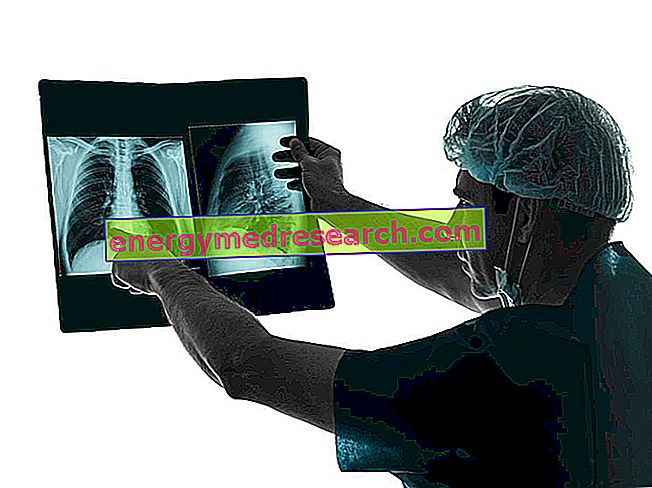Generality
The eyelid that trembles is a fairly frequent symptom that involves mild and infrequent spasms, similar to a vibration or a pulsation.

Although it can be annoying, this event is rarely synonymous with a disturbing disorder; in most cases, the eyelid that trembles is caused by the involuntary contraction of one of the eye muscles .
Usually, the trembling is unilateral and can involve both the upper and lower palpebral fissure.
This "over-stimulation" may depend on various reasons. Generally, the eyelid that trembles is a sign of excessive fatigue, stress and lack of sleep, therefore it must not arouse alarm in those who suffer from it. If the event becomes particularly frequent, however, it is advisable to consult a doctor for the appropriate checks.
What's this
The eyelid that trembles is a myoclonia, that is, a series of involuntary and intermittent muscle contractions, caused by a state of neuronal hyper-excitation .
Eyelid myoclonus (or myochemistry ) has variable duration, from a few seconds to a few hours. This manifestation may involve both the upper and lower eyelids.
Eyelid that Trembles: characteristics
- The trembling eyelid is an involuntary, abrupt and lightning-fast muscle contraction generated by the nervous system.
- The myoclonic spasm manifests itself, in particular, on the orbicular and upper elevator muscles, which allow the winking, the closing of the eyes and the other functions of the eyelid rhymes.
- The eyelid that trembles may vary due to the appearance (spontaneous or induced by a particular stimulus), the distribution (focal, segmental, multifocal or generalized) and the frequency (irregular or periodic).
- In some cases, the contraction takes on the characteristics of a real tic disorder, which is often associated with uncontrolled movements of the face and neck.
Causes
The trembling eyelid recognizes several causes.
In most cases, this disorder is transient and has no pathological significance, but is associated with stress and fatigue conditions . The most common reasons also include lack of sleep and excessive consumption of caffeine, alcohol or nicotine .

The eyelid that trembles may also be associated with " dry eye syndrome ", which may depend on a number of different factors, such as aging or certain therapies.
If the trembling of the eyelids involves both eyes, it is possible that the base has incorrect defects of vision . In fact, some visual disturbances can stimulate blinking and eyelid spasm.
The eyelid that trembles can also be a symptom of certain specific pathologies of the eye, including inflammation of the conjunctiva (conjunctivitis), blepharitis (inflammation of the eyelids), glaucoma or irritation of the cornea (presence of foreign bodies or corneal abrasion).
Less often, this manifestation is associated with cerebral or nerve disorders (such as epilepsy, multiple sclerosis or Parkinson's disease), metabolic disorders and unwanted reactions to drugs.
As for medicines, the flickering of the eye can be a side effect of antihistamines, antidepressants and nasal decongestants.
Eyelid that Trembles: most common causes
The most common causes of trembling eyelids are:
- Tiredness and stress ;
- Caffeine and alcohol abuse ;
- Nutritional imbalances (such as potassium and magnesium deficiencies);
- Fatigue of eyes (asthenopia) or visual stress from the use of computers, tablets and smartphones;
- Eye dryness, common especially among those who use contact lenses or antihistamines for treating allergies.
Other disorders you can associate with
The eyelid that trembles can be caused by a hemifacial spasm (a non-dystonic condition that involves various muscles on one side of the face, caused by irritation of the facial nerve).
The flickering of the eye can also be the first sign of a blepharospasm .
To learn more: Blafarospasm - Definition and Characteristics »In very rare cases, the eyelid that trembles can be a sign of:
- Epilepsy with palpebral myoclonia;
- Bell's palsy;
- Multiple sclerosis;
- Parkinson's disease;
- Some forms of dementia (Alzheimer's and Creutzfeldt-Jakob disease).
The eyelid that trembles can also manifest itself in the case of:
- Hypoxic-ischemic or traumatic brain damage;
- Systemic metabolic or toxic conditions, such as hypercarbia, hypoglycemia, hepatic decompensation, renal failure or drug intoxication;
- Viral encephalopathies (eg herpes simplex encephalitis) or toxic (eg exposure to heavy metals).
Symptoms and Complications
The eyelid that trembles is perceived as a series of rapid, sudden and uncontrolled movements of one or more muscles of the eye, determining phases of contraction (positive myoclonus) and relaxation phases (negative myoclonus).
Usually, the eyelid myoclonus manifests itself as an isolated, harmless and short-lived phenomenon. Sometimes, however, episodes can occur for a few days, resulting in quite annoying.
The vibration is rapid and intermittent, similar to a jolt, and can alternatively affect the right eye or the left eye or both eyes.
In the most serious cases, it can happen that to the eyelid that trembles is also added an abundant tearing, with reddening of the conjunctiva and eye irritation.
Symptoms associated with the eyelid that trembles
The eyelid that trembles does not cause pain, but can be associated with other ocular symptoms, such as:
- Eye strain;
- Tearing;
- Dry eyes;
- Blurred vision;
- Decreased visual acuity;
- Irritated or inflamed conjunctiva (red eyes);
- Foreign body sensation in the eye;
- photophobia;
- Sense of tension or bulbar pain.
Other times, eyelid tremor is related to general manifestations, including:
- Muscle weakness;
- Tachycardia
- Sweating;
- Insomnia;
- Muscle cramps or spasms;
- Hyporeflexia (diminished reflexes).
Some of these manifestations can be expression of more serious pathologies, but rather rare if compared to the eyelid that trembles.
When is the symptom of a more serious problem
The eyelid that trembles is almost always a harmless and transient phenomenon, attributable to a condition of emotional, physical or visual stress, easily solved. However, the problem is worrying if it lasts well over a couple of weeks or occurs constantly in terms of frequency and duration.
Chronic spasms can represent, for example, a symptom of disorders of the nervous system that are more serious than a simple psycho-physical tension or a lack of rest.
Generally speaking, the eyelid that trembles needs medical attention if:
- The flickering lasts over a couple of weeks or the phenomenon occurs frequently, negatively affecting daily activities;
- The eyelid is drooping and the eye is red, sore or has an unusual secretion;
- The vision is doubled;
- The eyelid closes completely with each contraction or the patient has difficulty opening the eyes;
- The pupil changes appearance;
- Facial spasms occur outside the eyelid.
Diagnosis
The evaluation of the eyelid shaking involves a careful medical history and a physical examination (ophthalmology and neurology), to determine the cause of the contraction of the muscles of the eye and to exclude associated eye diseases and / or any other underlying disorder.

Based on the outcome of these initial investigations, the doctor may prescribe further investigations, such as:
- Electromyography (EMG) : examination that allows to verify the muscular contraction under electrical stimulation by means of electrodes; electromyography is useful to identify which are the nerve endings that cause the eyelid that trembles;
- Magnetic resonance imaging (MRI) : a diagnostic imaging exam that allows the central nervous system (brain and spinal cord) to be viewed and the presence of any lesions to be assessed.
In general, in fact, it is always useful to identify the cause that triggered the eyelid myoclonia to intervene in the most correct way if it occurs again.
Treatment and Remedies
The eyelid that trembles must be considered above all as a passing and non-pathological phenomenon; rarely, these spasms are so severe as to require emergency treatment.
In any case, it is always advisable to contact your doctor for the most suitable indications for the specific situation. For example, in the presence of a brain tumor or spinal cord injury, it may be necessary to undergo surgery.
Eyelid Trembling: Drugs
In the absence of pathologies, the eyelid that trembles does not need pharmacological treatment, as it tends to resolve spontaneously.
When the phenomenon is determined by a specific underlying disease, however, the specialist may prescribe certain medicines. Although there are no specific drugs for the treatment of the eyelid that trembles, other classes of drugs may be useful in order to quell uncontrolled tremors, such as anti-convulsants, muscle relaxants or antiepileptics.
Eyelid Trembling: Remedies
Most ocular spasms are transient, although this manifestation can occur for weeks or even months.
The eyelid that trembles can be limited by some lifestyle changes :
- In cases of stress or fatigue, make sure you rest properly or use relaxation techniques (such as meditation or yoga). At the same time, consumption of coffee, alcohol or other stimulants of the nervous system should be reduced.
- If the eyelid that trembles depends on the dryness of the ocular surface, the doctor can recommend the instillation of artificial tears.
- Even limiting the amount of time spent in front of the screens of electronic devices (computers, tablets and smartphones) can help alleviate the disorder.
If the eyelid that trembles depends, instead, on a defect of vision, it may be sufficient to use adequate corrective lenses (glasses or contact lenses) to eliminate the disorder.



